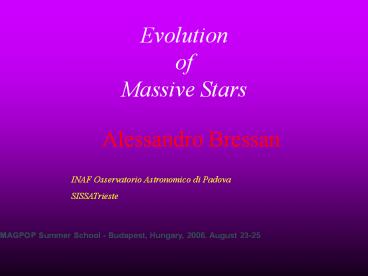Evolution of Massive Stars - PowerPoint PPT Presentation
1 / 31
Title:
Evolution of Massive Stars
Description:
Luminous Blue Variables. h Car. 100 x. more luminous. in the MIR. Wolf Rayet Stars. Luminous Blue Variables. WNL. N,He,H. WNE. N,He. WC. C, O. H (& He) Burning ... – PowerPoint PPT presentation
Number of Views:79
Avg rating:3.0/5.0
Title: Evolution of Massive Stars
1
EvolutionofMassive Stars
Alessandro Bressan
INAF Osservatorio Astronomico di
Padova SISSATrieste
MAGPOP Summer School - Budapest, Hungary, 2006.
August 23-25
2
Beginning from the end
WHICH IS THE PATH TO THE END ?
3
Why Study Massive Stars
- Provide most of the chemical mechanical energy
input into the interstellar medium - (stellar winds, supernova)
- Provide most of UV ionizing radiation of
galaxies, plus power the far-IR luminosities
through the heating of dust - Trace the star formation process in galaxies
- Are the source of the most energetic phenomenon
yet found (GRBs)
4
Massive Stars are Extremely Rare
- For every 20 M? star in the Milky Way, there are
roughly 105 solar-type stars. - For every 100 M? star, there are over 106
solar-type stars.
5
The HR Diagram
MW Humphreys Davidson 79
6
The HR Diagram
MW Humphreys Davidson 79
7
The HR Diagram
RED SUPERGIANTS
MW Humphreys Davidson 79
8
The HR Diagram
YELLOW GAP
MW Humphreys Davidson 79
9
The HR Diagram
MW Humphreys Davidson 79
10
Peculiar Objects
Luminous Blue Variables
11
h Car
100 x more luminous in the MIR
12
Wolf Rayet Stars
Luminous Blue Variables
WNL N,He,H
WC C, O
WNE N,He
13
H ( He) Burning
Massive stars characterized by a simple internal
structure
- Large convective nucleus (gt 50 of the star )
- surrounded by a radiative envelope
- Opacity dominated by e-scattering
- Perfect non-degenerate EOS with dominating
radiation pressure
14
Lower Mass Range
10 - 30 MŸ
15
Higher Mass Range M gt 30 MŸ
The evolution is dominated by mass-loss Note no
consistent models yet
Wind Velocity gt VESC (1000 km/s)
Mass Loss Rate 10-6 10-4 MŸ/yr
16
P-Cygni profile
Absorbing column tw. the photosphere
Emitting extended envelope
17
Radiative Wind Terminal Velocity
18
Evolution with mass loss
Initial Mass
NO RSG but WR
A fundamental question for the evolution of
massive stars Mass-Loss vs Metallicity ?
Final Mass
19
Mass-Loss Metallicity
O Supergiants
Log L/L? 7.03 (solid circles) 6.91 (open
circles) 6.76 (plus signs) 6.57 (asterisks)
6.42 (triangles) 6.30 (squares)
Kudritzki 2002
20
Mass-Loss Metallicity
Wolf Rayet Stars
Large Ge dependence
h 1 to 5 ! !
90-00 small dependence
Grafener Hamann 05
21
Mass LossduringRSG
Salasnich, Bressan Chiosi 99
22
HR DiagramMetallicity
23
HR DiagramMetallicity
24
Models with Rotation
Meynet Maeder 02
25
EnhancedRSGMassLoss
Salasnich, Bressan Chiosi 99
26
ARE WR WELL PREDICTED ?
Massey 03
- Number Ratio WC/WN
log (O/H)12
27
ARE WRsWELL PREDICTED ?
Atmospheres ?
28
Mass at the end of the quiescent life
Bressan et al 93
29
Effects of Rotation Maeder Meynet (02,03 etc..)
Final Mass
Initial Mass
30
Remnant Mass
NS
RM
31
Ultra Luminous X-Ray sourcesin Starbursts
32
Conclusions
- Massive star evolution compares generally well
with observations, yet some aspects remain unclear
Details or substantial modifications ? e.g. WR
L Teff
- RSG Mass-Loss
- changes evolution down to 15 M?
- Low Z mass loss at the Edd limit
- important for very massive stars































